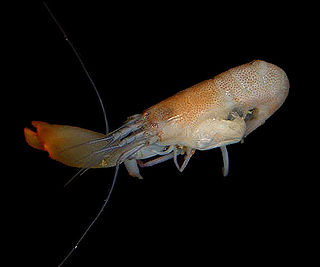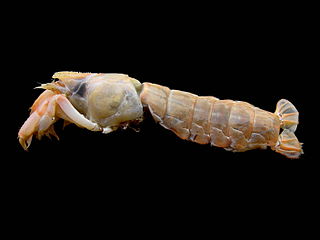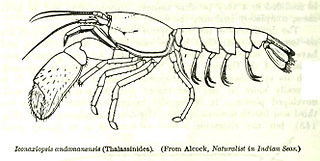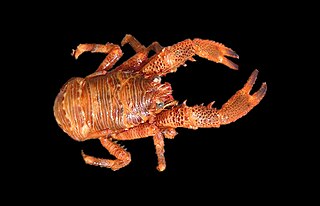
The Caridea, commonly known as caridean shrimp or true shrimp, from the Greek word καρίς, καρίδος, are an infraorder of shrimp within the order Decapoda. This infraorder contains all species of true shrimp. They are found widely around the world in both fresh and salt water. Many other animals with similar names – such as the mud shrimp of Axiidea and the boxer shrimp of Stenopodidea – are not true shrimp, but many have evolved features similar to true shrimp.

Axiidea is an infraorder of decapod crustaceans. They are colloquially known as mud shrimp, ghost shrimp, or burrowing shrimp; however, these decapods are only distantly related to true shrimp. Axiidea and Gebiidea are divergent infraoders of the former infraorder Thalassinidea. These infraorders have converged ecologically and morphologically as burrowing forms. Based on molecular evidence as of 2009, it is now widely believed that these two infraorders represent two distinct lineages separate from one another. Since this is a recent change, much of the literature and research surrounding these infraorders still refers to the Axiidea and Gebiidea in combination as "thalassinidean" for the sake of clarity and reference. This division based on molecular evidence is consistent with the groupings proposed by Robert Gurney in 1938 based on larval developmental stages.

Synalpheus is a genus of snapping shrimp of the family Alpheidae, presently containing more than 160 species; new ones are described on a regular basis, and the exact number even of described species is disputed.

Upogebiidae is a family of mud shrimp crustaceans belonging to the infraorder Gebiidea, within the order Decapoda. They are infauna, living their entire adult lives in seafloor burrows. Over 100 species have been identified, with different species often highly specialized for different types of substrate, even including sea sponges or coral. They are filter feeders, although some species also deposit feed.

Axiidae is a family of crustaceans belonging to the infraorder Axiidea, within the order Decapoda.

Eiconaxius andamanensis is a species in the family Axiidae. Although it is not a true lobster, is sometimes known by the common names "mud lobster" and "scorpion lobster". Its scientific name comes from the Andaman Sea, where it has been collected off the west coast of Andaman Islands at a depth of 238–290 fathoms.

Galathea is a genus of squat lobsters in the family Galatheidae. It is one of the largest genera of squat lobsters that in 2008 contained 73 species. Most species of Galathea live in shallow waters.
Eiconaxius cristagalli is a species of mud lobster from the Pacific Ocean.

Munidopsis is a genus of squat lobster. It is the second largest of all the genera of squat lobsters, after Munida, with over 200 species. Its members are mainly found on continental slopes and on abyssal plains. A few fossil species are also known, including specimens from the Campanian (Cretaceous).
Nanogalathea is a genus of squat lobster from the Bay of Bengal. Two species in the genus Nanogalathea.

Lepidophthalmus turneranus, the Cameroon ghost shrimp, is a species of "ghost shrimp" or "mud lobster" that lives off the coast of West Africa. It occasionally erupts into dense swarms, one of which resulted in the naming of the country Cameroon.

Leucosiidae is a family of crabs containing three subfamilies and a number of genera incertae sedis:

Dorphinaxius kermadecensis is a species of mud lobster native to the Norfolk Island, parts of New South Wales, and the Kermadec Islands of New Zealand. It is the only species in the genus Dorphinaxius. It has a depth range of 0–8 metres (0–26 ft).

Acanthaxius is a genus of mud lobster native to the Indo-Pacific oceans. It has a slender rostrum which is longer than the eyestalks, is spinose and has seven spines and has a depth range of 228–438 metres (748–1,437 ft).

Callichirus major sensu lato is a monophyletic species complex of ghost shrimp in the infraorder Axiidea, found in flat sandy beaches across the Pan-American coastline.

Laomediidae is a family of mud shrimp crustaceans belonging to the infraorder Gebiidea, within the order Decapoda.
Atyoida is a genus of freshwater shrimp in the family Atyidae. There are five species in the genus, each endemic to a different Pacific island group. The type species, Atyoida bisulcata, is endemic to Hawaiʻi and described by John Witt Randall in 1840.
Neolithodes indicus is a species of king crab found in the southeastern Arabian Sea. It has been found at depths between 743–1,829 m (2,438–6,001 ft). It was originally identified erroneously as Lithodes agassizii by A.R.S. Anderson in 1896.
Guyanacaris caespitosa is a species of ghost shrimp found in the eastern Pacific Ocean off the coast of Colombia. It was originally described as being in the genus Axiopsis and later in the genus Acanthaxius. It has been found at a depth of 90 metres (300 ft).

Gordonopsis is a genus of deep-sea porter crabs in the family Homolidae. The Homolidae are also known as carrier crabs or porter crabs for their fifth pereiopods, which they use to hold objects in place over the rear half of the carapace in a possible defence mechanism against predators. Species of Gordonopsis are found in deep waters of the Indo-West Pacific region. The genus was erected in 1995 by Danièle Guinot and Bertrand Richer de Forges.












